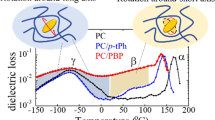Abstract:
Relaxations in amorphous bis-phenol A polycarbonate are studied by neutron scattering, as a function of temperature below the glass transition. Two different processes are observed. One is very fast, with a characteristic time (∼ 0.3 ps), that is independent of temperature and momentum transfer. Conversely the other is slower, with a time which is dependent on temperature and momentum transfer. The very fast localized anharmonic motion is interpreted by the overdamping of low-frequency vibrational modes, by nearby dynamic holes. The slower relaxation is thermally activated and momentum transfer dependent. It corresponds to molecular group motions and possibly to the short-time regime of the segmental relaxation.
Similar content being viewed by others
Author information
Authors and Affiliations
Additional information
Received 29 February 2000 and Received in final form 13 June 2000
Rights and permissions
About this article
Cite this article
Saviot, L., Duval, E., Jal, J. et al. Very fast relaxation in polycarbonate glass. Eur. Phys. J. B 17, 661–666 (2000). https://doi.org/10.1007/s100510070105
Issue Date:
DOI: https://doi.org/10.1007/s100510070105




